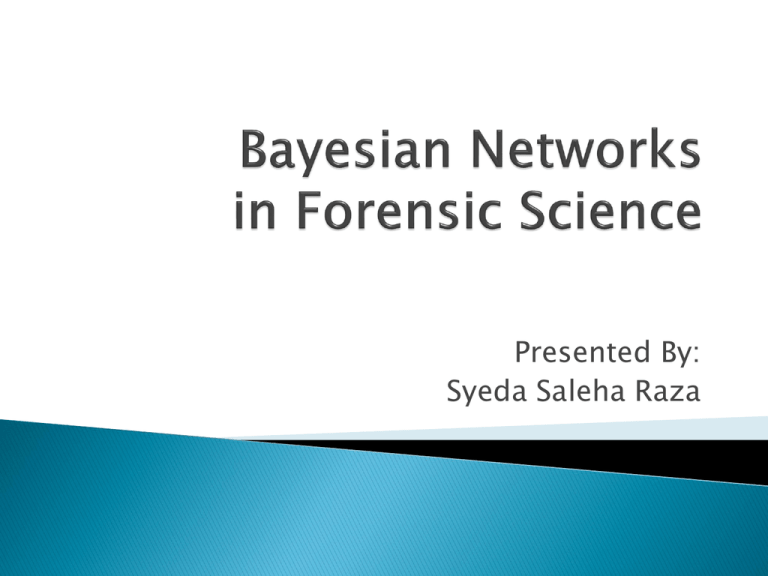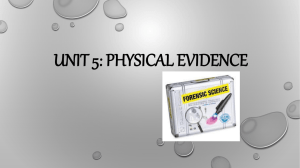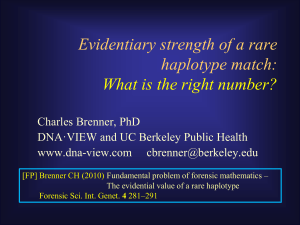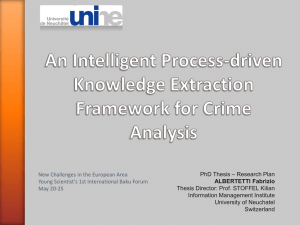Bayesian Networks in Forensic Science
advertisement

Presented By: Syeda Saleha Raza A young girl, Lulu, has been found murdered at her home with many knife wounds. The knife has not been found. Some bloodstains have been recovered on the scene of the crime which do not share Lulu’s DNA profile. A friend of hers, Jack, has been seen near Lulu’s house around the time of the murder by John. There is some evidence that Jack was badly in love with Lulu. Though It is not known for certain, Instead, it is a hypothesis based on information which is not totally reliable and a hypothesis that can furnish an alternative explanation of Jack’s presence near Lulu’s house. John has stated that he also was interested In Lulu. A blood sample has been taken from Jack. It is also assumed that the fact that John himself fell in love with Lulu can prejudice his reliability as a witness. Jack may or may not be offender. Crime stain may or may not be relevant to the case. Jack may or may not be in love with Lulu. John may or may not be prejudiced against Jack. Forensic Scientists have some hypothesis in hand ( e.g. jack stabbed Lulu) and they assess the likelihood of that hypothesis under the given scientific evidences. The interpretation of scientific evidence may be thought of as the assessment of a comparison. This comparison is between evidential material found at the scene of a crime and evidential material found on a suspect, a suspect’s clothing or around his environment. Odds of an event E = P(E) / P(~E) Odds of 1indicates that we believe in both the events E & ~E equally. Odds of 5 indicates that we believe in E 5 times more than we believe in ~E. The odds form of Bayes’ Theorem then enables the prior odds (i.e., prior to the presentation of Ev) in favor of guilt to be updated to posterior odds given Ev, the evidence under consideration. This is done by multiplying the prior odds by the likelihood ratio which, in this context, is the ratio of the probabilities of the evidence assuming guilt and assuming innocence of the suspect. In the evaluation of the evidence Ev, it is two probabilities that are necessary: the probability of the evidence if the suspect is guilty and the probability of the evidence if the suspect is innocent. For example, it is not sufficient to consider only the probability of the evidence if the suspect is innocent and to declare that a small value of this is indicative of guilt. The probability of the evidence if the suspect is guilty also has to be considered. Similarly, it is not sufficient to consider only the probability of the evidence if the suspect is guilty and to declare that a high value of this is indicative of guilt. The probability of the evidence if the suspect is innocent is also to be considered. Forensic Scientists assist the evaluation of scientific evidences through the assessment of likelihood ratio (V) which is a consideration of the probability of the evidence given both competing propositions are of interest. The likelihood ratio(V) is the ratio of posterior odds to prior odds. The likelihood ratio converts the prior odds in favor of Hp into the posterior odds in favor of Hp. V = The likelihood ratio may be thought of as the value of the evidence. Principal Nodes ◦ ◦ ◦ ◦ H: Suspect is offender G: Blood stain found on crime scene comes from offender F: Blood stain found on crime scene comes from suspect E: Suspect blood sample and crime scene stain share same DNA profile Information may only be transmitted through a converging connection if there is some evidence (hard or soft) bearing on the middle variable or there is some evidence bearing on one of its descendants. Knowing that the DNA profile of the bloodstain matches the profile of the blood sample of the suspect, i.e., knowing the state of child E of C, opens the channel between A and B because this information, in turn, changes the degree of belief in C, even though this degree is still lower than certainty, allowing for the possibility of a random match. While considering footwear marks, there can be multiple components found that need to separately assessed. ◦ Xm/Xa: Manufacturing (Acquired) characteristic of shoeprint gathered from suspect’s shoe. ◦ Ym/Ya = Manufacturing (Acquired) characteristic of shoeprint gathered from crime scene. Bayesian networks seem widely applicable in the domain of forensic to model uncertainties and to make inferences. Following factors increase their viability in the domain of forensic sciences : ◦ There can be different type of evidential material involved incurring their inherent uncertainties. Examples are: Stains gathered from body fluid Mark Evidences ( Finger print, Shoeprints, Firearm/tool mark) DNA Profiling (Relatedness testing) Transfer evidence (Fibers, Glass, Paint) ◦ Situation can further be complicated by considering more than one offenders and different type of evidences involved. ◦ These evidences may be gathered from different places and in different points in time. [1] Chapter 2,4 & 5 - Bayesian Networks and Probabilistic Inference in Forensic Science [2] Inference Problems in forensic Science Franco Taroni and Alex Biedermann











